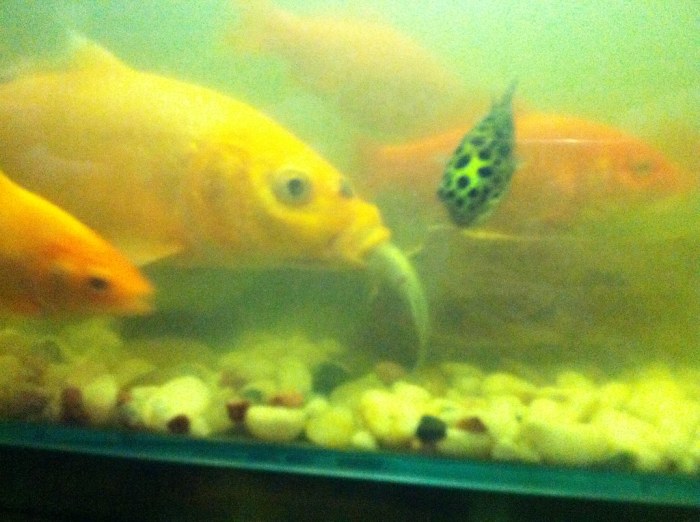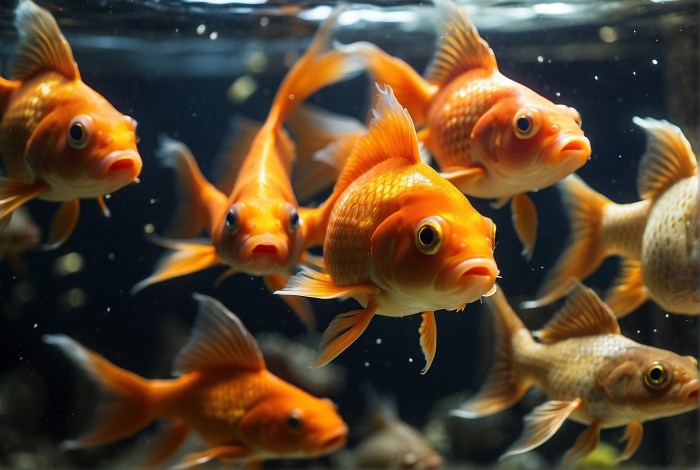Can goldfish eat other fish? The answer, unfortunately, is yes. While these seemingly docile creatures are often seen as peaceful companions in aquariums, goldfish possess a natural predatory instinct that can sometimes lead to unexpected consequences. Understanding their feeding habits, behavior, and the factors that can trigger aggression is crucial for ensuring the safety and well-being of all fish in a shared tank.
Goldfish, in their natural habitat, are omnivores with a diet that includes algae, insects, and even smaller fish. This predatory behavior, however, doesn’t always translate seamlessly to the confines of a home aquarium. Factors like overcrowding, inadequate space, and competition for resources can amplify aggression and increase the risk of cannibalism, where goldfish may prey on their tank mates.
Goldfish Diet
Goldfish, like all living creatures, require a balanced diet to thrive. Understanding their nutritional needs is crucial for keeping them healthy and happy. In the wild, goldfish have access to a diverse range of foods, but in captivity, their diet relies heavily on what their owners provide.
Natural Diet of Goldfish
In their natural habitat, goldfish are omnivorous, consuming a variety of food sources. They primarily feed on algae, aquatic plants, insects, and small invertebrates. This varied diet provides them with essential nutrients, such as protein, carbohydrates, vitamins, and minerals.
Nutritional Needs of Goldfish in Captivity
While goldfish can survive on a diet of commercial flakes and pellets, it’s essential to provide them with a balanced diet that meets their specific nutritional needs. These needs include:
- Protein: Protein is crucial for muscle growth, tissue repair, and overall health. Goldfish require a diet with at least 30% protein.
- Carbohydrates: Carbohydrates provide energy for goldfish, particularly for active swimming.
- Vitamins: Vitamins are essential for various bodily functions, including vision, immune system health, and growth. Some important vitamins for goldfish include Vitamin A, D, E, and C.
- Minerals: Minerals play a vital role in maintaining bone health, regulating fluid balance, and supporting various metabolic processes. Essential minerals for goldfish include calcium, phosphorus, and magnesium.
Common Goldfish Food Options
A variety of food options are available for goldfish, each with its own advantages and disadvantages:
- Flakes: Flakes are a convenient and widely available food option. They typically contain a mix of ingredients, including protein, carbohydrates, and vitamins. However, flakes can sometimes be low in nutritional value and may not provide enough variety for goldfish.
- Pellets: Pellets are a more concentrated food source than flakes, providing a higher level of protein and other nutrients. They are also more durable and less likely to dissolve quickly in the water.
- Live Foods: Live foods, such as brine shrimp, bloodworms, and daphnia, offer a natural and highly nutritious diet for goldfish. They are high in protein and essential fatty acids, promoting healthy growth and development.
Feeding Frequency and Amount
The frequency and amount of food you give your goldfish depends on several factors, including their size, activity level, and water temperature.
A general guideline is to feed goldfish twice a day, offering only as much food as they can consume within a few minutes.
- Size: Smaller goldfish require more frequent feedings, while larger goldfish can be fed less often.
- Activity Level: Active goldfish need more food than less active ones.
- Water Temperature: Goldfish are more active in warmer water and may require more food during these periods.
Goldfish Behavior and Aggression

Goldfish, known for their peaceful demeanor and vibrant colors, can sometimes exhibit aggressive behavior. Understanding the factors that contribute to aggression and recognizing the signs can help prevent and manage these issues, ensuring the well-being of your goldfish.
While goldfish are generally herbivores, they can sometimes exhibit opportunistic carnivorous tendencies. They might nibble on smaller fish, especially if they’re feeling particularly hungry or if the smaller fish is injured or dead. However, their primary diet consists of plants and algae, and they can also safely consume worms, which are a good source of protein.
To learn more about whether goldfish can eat worms, check out this article: can goldfish eat worms. While they may eat other fish occasionally, their primary diet should consist of plant-based foods, as their digestive system is primarily designed for that.
Factors Contributing to Aggression, Can goldfish eat other fish
Several factors can contribute to aggression in goldfish, including:
- Overcrowding:Limited space can lead to competition for resources, such as food and territory, escalating tensions and aggression. Goldfish are social animals, but overcrowding can create a stressful environment, triggering aggressive behavior. For example, a 10-gallon tank is generally suitable for one or two small goldfish, but housing five or more in the same space can lead to constant territorial disputes.
- Lack of Space:Even with adequate tank size, goldfish may become aggressive if they lack sufficient space to swim and explore. For example, a 20-gallon tank may seem spacious, but if it’s filled with decorations and hiding places, leaving little open swimming area, it can lead to aggression.
While goldfish are generally herbivores, they can sometimes exhibit opportunistic carnivorous tendencies. They might nibble on smaller fish, especially if they’re feeling particularly hungry or if the smaller fish are injured or weak. However, it’s important to remember that goldfish have different dietary needs than betta fish, and their digestive systems are not designed for the same types of food.
If you’re considering feeding your goldfish betta food, it’s crucial to research the nutritional content and whether it’s appropriate for your goldfish’s specific needs. Can goldfish eat betta food ? The answer is not as straightforward as it may seem.
Ultimately, providing your goldfish with a balanced diet that caters to their unique needs is essential for their overall health and well-being.
Goldfish require space to establish territories and maintain social distance, preventing unwanted encounters.
- Competition for Resources:Limited food supply, particularly when goldfish are not fed adequately, can lead to competition and aggression. Goldfish, especially when hungry, may become territorial, nipping at or chasing other fish to secure access to food. Ensuring adequate feeding and avoiding overfeeding are crucial in maintaining peace.
- Hormonal Changes:During breeding season, goldfish can become more aggressive as their hormones fluctuate. Male goldfish, in particular, may become more territorial and aggressive towards other males, competing for the attention of females.
Types of Aggression
Goldfish can exhibit various forms of aggression, each with its own characteristics:
- Nipping:This involves a goldfish using its mouth to gently bite or nibble at another fish’s fins or body. It’s often a territorial behavior, asserting dominance or defending a particular space. Nipping can cause minor damage, but it’s usually not life-threatening.
- Chasing:This involves a goldfish persistently pursuing another fish, often without directly biting or nipping. Chasing can be a form of territorial display or a way to intimidate other fish, establishing dominance. While chasing can be stressful, it’s typically not as harmful as biting or nipping.
- Biting:This involves a goldfish using its mouth to inflict more significant damage on another fish. Biting can be a response to competition for food, territory, or even a perceived threat. Biting can cause severe injuries, including fin damage, open wounds, and even death.
While goldfish are omnivores and can consume a variety of foods, their diet should primarily consist of commercially prepared fish flakes or pellets. While they might nibble on small invertebrates, it’s not recommended to feed them other fish, as this can introduce parasites and diseases.
However, you might be wondering if they can eat something else entirely, like vegetables. Can goldfish eat celery? Click here to learn more about goldfish and celery. Although celery is not toxic to goldfish, it’s best to stick to their regular diet and avoid offering them human foods.
Signs of Aggression
Recognizing the signs of aggression is crucial for addressing the issue promptly. Some common signs include:
- Fin Damage:Torn, frayed, or missing fins are a common sign of aggression. Goldfish may nibble at each other’s fins during territorial disputes or as a result of competition for food.
- Injuries:Open wounds, cuts, or abrasions on the body are a clear indication of aggression. These injuries can be caused by biting, nipping, or even rough play.
- Changes in Behavior:Goldfish that are normally active and social may become withdrawn, hiding, or constantly swimming in circles. This can be a sign of stress or fear caused by aggression from other fish.
Cannibalism in Goldfish: Can Goldfish Eat Other Fish

While often considered peaceful, goldfish can exhibit cannibalistic behavior under certain circumstances. This unsettling phenomenon, while not common, can be a serious threat to the health and well-being of your goldfish. Understanding the factors that trigger cannibalism is crucial for maintaining a harmonious and safe environment for your finned companions.
Factors Triggering Cannibalism
Cannibalism in goldfish is typically triggered by a combination of environmental and behavioral factors. These include:
- Hunger:When food is scarce, goldfish may resort to eating each other to survive. This is particularly true in overcrowded tanks where competition for food is intense.
- Stress:Crowded living conditions, poor water quality, and aggressive tank mates can lead to stress, making goldfish more prone to aggression and cannibalism.
- Overcrowding:Limited space and inadequate hiding places can increase competition for resources and lead to aggression, increasing the risk of cannibalism.
- Aggression:Certain goldfish breeds are naturally more aggressive than others, making them more likely to engage in cannibalistic behavior.
- Size Disparity:A significant size difference between goldfish can lead to bullying and predation, where larger fish may prey on smaller ones.
Identifying Cannibalism
Cannibalistic behavior can be recognized through several telltale signs:
- Missing Fins:Fins that have been nibbled or torn are a strong indication of cannibalism.
- Wounds and Scars:Injuries, bites, or open wounds on the body of a goldfish are often signs of aggression, potentially from cannibalism.
- Presence of Fish Remains:Finding remains of smaller goldfish in the tank is a clear sign of cannibalism.
Preventing Cannibalism
Preventing cannibalism requires a proactive approach to ensure the safety and well-being of your goldfish. Here are some practical tips:
- Provide Ample Space:Ensure your tank is adequately sized for the number of goldfish you have. A good rule of thumb is 10 gallons of water per inch of goldfish length.
- Offer Hiding Places:Provide ample hiding places, such as caves, plants, and driftwood, to reduce stress and competition for space.
- Maintain Water Quality:Regular water changes and proper filtration are crucial for maintaining healthy water conditions, reducing stress, and preventing disease, all of which can contribute to aggression and cannibalism.
- Feed a Balanced Diet:Provide a varied and nutritious diet to ensure your goldfish are well-fed and less likely to resort to cannibalism.
- Monitor Behavior:Regularly observe your goldfish for signs of aggression or cannibalism.
- Separate Aggressive Fish:If you notice any aggressive behavior, it may be necessary to separate the fish involved.
Concluding Remarks

Creating a safe and harmonious environment for goldfish involves more than just providing food and water. Understanding their natural instincts, potential for aggression, and the importance of appropriate tank mates is crucial for preventing unwanted consequences. By providing ample space, hiding places, and a balanced diet, you can minimize the risk of cannibalism and ensure that your goldfish thrive in a peaceful and enriching environment.